

Nano-Material with Color and Texture of Butterfly Wings. Penn Researchers Find New Way to Mimic the Color and Texture of Butterfly Wings. Butterfly wings biomimicry for dirt free coated surfaces. Aside the technology being used to generate the energy from the sun, the efficiency of solar panels also depends on the cleanliness of the panels.
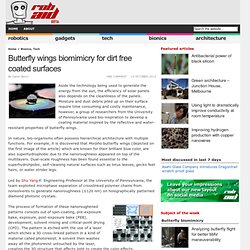
Moisture and dust debris piled up on their surface require time consuming and costly maintenance, however, a group of researchers from the University of Pennsylvania used bio-inspiration to develop a coating material inspired by the reflective and water-resistant properties of butterfly wings. In nature, bio-organisms often possess hierarchical architecture with multiple functions. For example, it is discovered that Morpho butterfly wings (depicted on the first image of the article) which are known for their brilliant blue color, are also superhydrophobic due to the nanoroughness appeared on top of the multilayers. Dual-scale roughness has been found essential to the superhydrohpobic, self-cleaning natural surfaces such as lotus leaves, gecko feet hairs, or water strider legs. Led by Shu Yang. Interview With Professor Shu Yang Of The University of Pennsylvania. Image Caption: A drop of water sits on a material with structural color and superhydrophobicity.
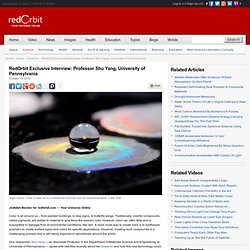
Credit: AFM Jedidiah Becker for redOrbit.com — Your Universe Online Color is all around us – from painted buildings, to stop signs, to butterfly wings. Traditionally, colorful compounds, called pigments, are added to material to give them the desired color. However, color can often fade and is susceptible to damage from environmental conditions, like rain. One researcher, Shu Yang — an Associate Professor in the Department of Materials Science and Engineering at University of Pennsylvania — spoke with redOrbit recently about her research and how this new technology could change the way we apply color to our world.
Interview RO: From your personal webpage, we can see that you´ve been involved in several research projects that involve synthesizing polymers and other inorganic materials. RO: What kind of technical challenges did your team face in trying to combine these two unique properties? Penn Reserchers Use Holographic Lithography to Mimic Color of Butterfly Wings. Shu Yang A team of researchers at the University of Pennsylvania has found a way to generate this kind of “structural color” that has the added benefit of another trait of butterfly wings: super-hydrophobicity, or the ability to strongly repel water.
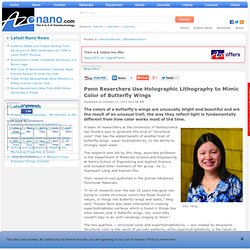
The research was led by Shu Yang, associate professor in the Department of Materials Science and Engineering at Penn’s School of Engineering and Applied Science, and included other members of her group: Jie Li, Guanquan Liang and Xuelian Zhu. Their research was published in the journal Advanced Functional Materials. New way to mimic the color and texture of butterfly wings. The colors of a butterfly's wings are unusually bright and beautiful and are the result of an unusual trait; the way they reflect light is fundamentally different from how color works most of the time.
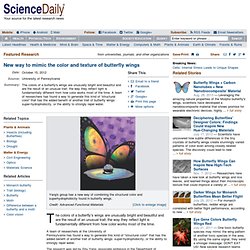
A team of researchers at the University of Pennsylvania has found a way to generate this kind of "structural color" that has the added benefit of another trait of butterfly wings: super-hydrophobicity, or the ability to strongly repel water. The research was led by Shu Yang, associate professor in the Department of Materials Science and Engineering at Penn's School of Engineering and Applied Science, and included other members of her group: Jie Li, Guanquan Liang and Xuelian Zhu. Their research was published in the journal Advanced Functional Materials. "A lot of research over the last 10 years has gone into trying to create structural colors like those found in nature, in things like butterfly wings and opals," Yang said. " "The good solvent causes the structure to swell," Yang said. Penn Engineering - Welcome to the School of Engineering and Applied Science (SEAS)
Welcome to the Department of Materials Science and Engineering (MSE) SHU YANG GROUP. Penn Engineering - Research Directory Profile. Email | Research Webpage Honors and Awards: NSF CAREER Award - 2006, World's 100 Top Young Innovators by Technology Review - 2004, Unilever Award in Polymer Science and Engineering from American Chemical Society - 2001, ICI Award in Applied Polymer Science from American Chemical Society - 1999 Research Expertise: Biomaterials | Polymers | Nanostructured materials Shu is interested in developing new methodologies for the controlled synthesis, fabrication and characterization of materials with specific and unique structures and functionalities inspired by biology.
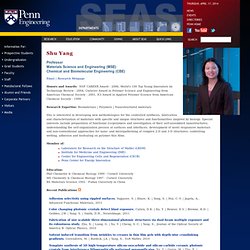
SHU YANG GROUP. Web of Knowledge ResearcherID: D-9758-2011, Patents Li, J., Cho, Y., Choi, I. and Yang, S.*,"Transforming One-Dimensional Nanowalls to Long-Range Ordered Two-Dimensional Nanowaves – Exploiting Buckling Instability and Nanofibers Effect in Holographic Lithography", Adv.
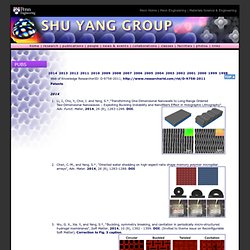
Funct. Mater, 2014, 26 (8), 1283-1288. 7. 8. Gharbi, M. Beller, D. Honglawan, A.†, Beller, D. Honglawan, A, and Yang, S.*, “Evaporative assembly of ordered microporous films and their hierarchical structures from amphiphilic random copolymers”, Soft Matter, 2012, 8 (47), 11897 - 11904. Hsieh, W. Chandra, D.* and Yang, S.*, “Dynamics of a Droplet Imbibing on a Rough Surface”, Langmuir, 2011, 27 (22), 13401-13405. Nano-material copies butterfly colors. U.

PENNSYLVANIA (US) — Researchers have figured out how to recreate the bright, beautiful colors of butterfly wings, as well as their ability to strongly repel water. The colors of a butterfly’s wings are the result of an unusual trait—the way they reflect light is fundamentally different from how color works most of the time. A team of researchers at the University of Pennsylvania has found a way to generate this kind of “structural color.” Shu Yang, associate professor in the department of materials science and engineering, led the research. She and colleagues report their findings in the journal Advanced Functional Materials. “A lot of research over the last 10 years has gone into trying to create structural colors like those found in nature, in things like butterfly wings and opals,” Yang says.
The two qualities—structural color and superhydrophobicity—are related by structures. “The good solvent causes the structure to swell,” Yang says. Exploiting Nanoroughness on Holographically Patterned Three-Dimensional Photonic Crystals - Li - 2012 - Advanced Functional Materials.